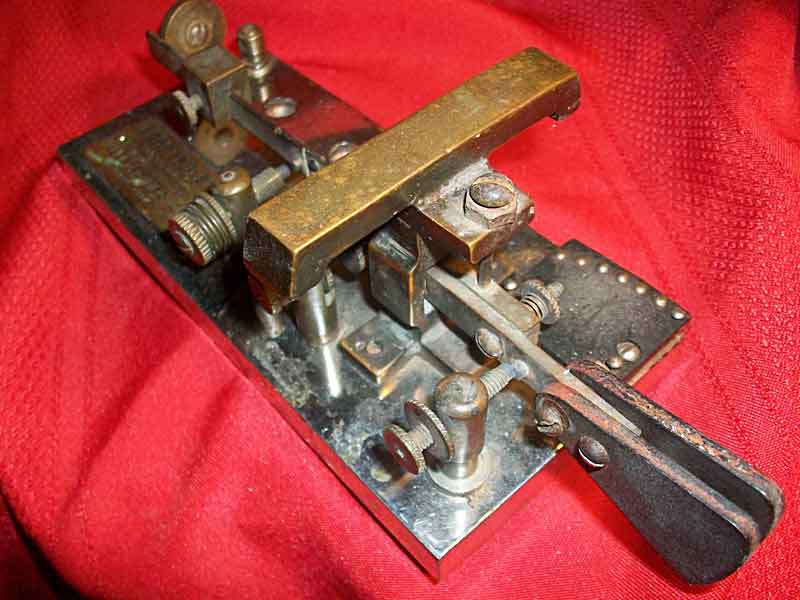
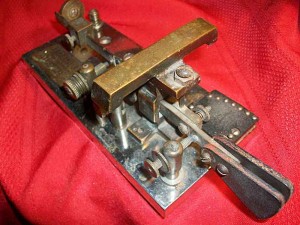
Sunday, Aug. 19, 2012 — The Electro Manufacturing Co. of Fresno, Calif., produced the unique line of semi-automatic keys in the late 1920s and early 1930s. The example of the deluxe Electro Bug shown here was picked up from eBay near the end of May 2012. It was inexpensive, given the fact that its missing several important parts that collectors want to see on the Electro Bug.
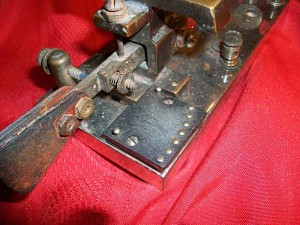
The two large mounting holes on the base near the terminal screws are where a metal box containing an electromagnetic coil would be mounted on a complete Electro Bug. The operater had the option of using the key like a normal bug, or use the telegraph circuit current to power the electromagnetic coil to assist in the sending of dots.
If you look at the front of the bug, you’ll see a pad there on the front right corner with a series of contacts. Originally, a lever similar to a circuit closer would be mounted there and the operator could adjust the how the electromagnet’s strength by adjusting the lever to certain positions to raise and lower the voltage. The s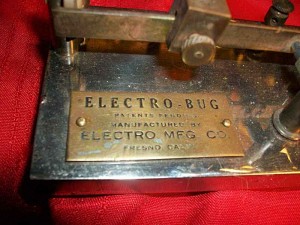 witch also allowed the operator to cut off power to the relay and let it operate like a traditional bug. Obviously on this key the selection lever is missing.
witch also allowed the operator to cut off power to the relay and let it operate like a traditional bug. Obviously on this key the selection lever is missing.
This key is the “deluxe” model which featured nickle plating on the base. The other Electro Bug I own has a black finished base.
There’s no denying the similarity between this key and the later Speed-X T-bar Models 500 and 501. They are similar, but have some differences.
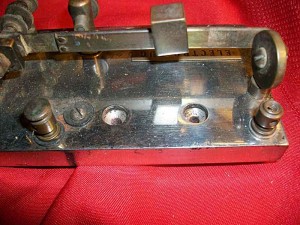
The Speed-X t-bar is cast pot metal while the Electro Bug t-bar is brass. The Electro Bug’s dot contact on the pendulum is not mounted on any sort of spring — the contact point is mounted on the pendulum. I suspect this would dampen the lever’s vibrations when unassisted by the electromagnet; I have not compared it to other keys to determine if that’s true.
I have two Electro Bugs now, the other is more complete, but also lacks the electromagnet assembly. I have seen more Electro Bugs without it than with in my surveys of eBay keys; those with the electromagnet seem to command higher prices, naturally.
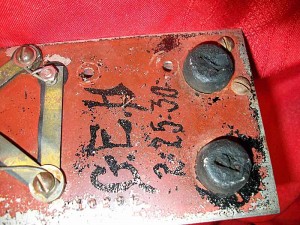
Why buy an incomplete key? These keys are uncommon in any condition. I also liked the date and operator’s initials on the bottom of the key. There are numbers stamped on the bottom, and I’m not sure if it is a serial number or operator number for the key.
The date confirms this as an early Electro Bug. The company later moved from Fresno to San Fransisco, which is where the Speed-X line of keys was launched a few years later after Stewart Johnson purchased the Electro Manufacturing Co. Johnson wisely discards the electromagnetic part of the Electro Bug for the Speed-X line.
However, in the history of the Speed-X line, the earliest of the company’s keys had no name plate or ID. The familiar Model 500 and 501 seemed to arrive after the “early” keys, leaving one to wonder if Speed-X waited a few years before releasing the 500 series. Any Speed-X experts out there who might know the answer?
Electro Bug also had a plain, all-mechanical semi-automatic key, the Electro Bug Jr. I have one of those in my collection, and it is complete. One of these days I’ll add a complete Electro Bug to my collection … one of these days … repeat after me … hi hi.
-30-
